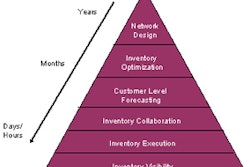Atlanta — December 20, 2006 — World-class procurement organizations now spend 25 percent less on procurement operations than typical companies while demonstrating improved effectiveness that enables them to generate twice the annualized reductions in direct and indirect spending, according to research from strategic advisory firm The Hackett Group
In its the 2006 Enterprise Book of Numbers, Hackett writes that world-class performers are reaping significant benefits by focusing on strategic management in key areas such as sourcing opportunities, supplier management and the application of technology investments.
Hackett's findings suggest several key areas in which procurement can realize significant improvements in efficiency and effectiveness, including reduced costs, which are often overlooked by the world's largest companies:
According to Hackett's recent analysis, the leading procurement organizations now spend 25 percent less on procurement operations than typical companies (0.85 percent of annual spending versus 0.64 percent). Their improved effectiveness also enables world-class procurement organizations to drive reductions in direct and indirect spending equal to more than 10 times this cost gap, generating $23 million per billion in annualized savings that typical companies don't see.
And while world-class procurement organizations continue to aggressively manage their direct spending, they are also managing previously untapped spending areas in indirect (i.e., non-production) spending, achieving annualized spending reductions of 4 percent while typical companies see only a 1.7 percent reduction.
"Most companies try to focus on cutting direct spending, but not only are world-class companies simply better at it than their peers, they also focus heavily on the challenge of reducing all their indirect spending areas," said Chris Sawchuk, procurement practice leader at The Hackett Group. "This is tougher, as procurement has less control, but still needs to influence budget-holders by coordinating spending activities in order to reduce unnecessary spending and get the most value from their spending with external suppliers. But it's far from impossible.
Partnering Key
As a result, world-class performers garner substantial savings that typical procurement organizations simply don't see, Sawchuk said. "The top performers are ahead of the curve and have successfully implemented best practices that focus on developing processes and managing relationships both within and outside the enterprise to deliver long-term cost benefits," the analyst said.
According to Hackett's research, world-class procurement organizations look for opportunities to help other business units operate at a higher level. Procurement touches every area of an organization through direct or indirect spending and should be part of a corporate plan to compete, Hackett said.
"Rather than think of themselves as underappreciated cost centers, world-class procurement executives reinvent their functions as service providers and treat their cross-functional counterparts as highly valued customers," said Hackett Senior Business Advisor Pierre Mitchell. "As a result, they align their procurement strategies with those of their internal customers and thereby provide significant strategic value to their company."
Five Best Practices
Hackett's 2006 Enterprise Book of Numbers, "2006 World-Class Metrics: The 5 Best Practices of World-Class Companies," which is available to members of the firm's advisory programs, details five best practices that empirically correspond to world-class performance in procurement and other sales, general and administration (SG&A) areas: strategic alignment, cross-functional partnering; complexity reduction; technology enablement; and business process sourcing. Key findings in each of these areas include:
In its the 2006 Enterprise Book of Numbers, Hackett writes that world-class performers are reaping significant benefits by focusing on strategic management in key areas such as sourcing opportunities, supplier management and the application of technology investments.
Hackett's findings suggest several key areas in which procurement can realize significant improvements in efficiency and effectiveness, including reduced costs, which are often overlooked by the world's largest companies:
- Re-engineering supplier and internal organizational relationships to gain economies of scale and improve leverage in cost negotiations.
- Developing long-term relationships designed to avoid unnecessary costs and protect procurement from future price increases and market fluctuations.
- Smarter spending on enabling technology to simplify processes and reduce labor costs.
According to Hackett's recent analysis, the leading procurement organizations now spend 25 percent less on procurement operations than typical companies (0.85 percent of annual spending versus 0.64 percent). Their improved effectiveness also enables world-class procurement organizations to drive reductions in direct and indirect spending equal to more than 10 times this cost gap, generating $23 million per billion in annualized savings that typical companies don't see.
And while world-class procurement organizations continue to aggressively manage their direct spending, they are also managing previously untapped spending areas in indirect (i.e., non-production) spending, achieving annualized spending reductions of 4 percent while typical companies see only a 1.7 percent reduction.
"Most companies try to focus on cutting direct spending, but not only are world-class companies simply better at it than their peers, they also focus heavily on the challenge of reducing all their indirect spending areas," said Chris Sawchuk, procurement practice leader at The Hackett Group. "This is tougher, as procurement has less control, but still needs to influence budget-holders by coordinating spending activities in order to reduce unnecessary spending and get the most value from their spending with external suppliers. But it's far from impossible.
Partnering Key
As a result, world-class performers garner substantial savings that typical procurement organizations simply don't see, Sawchuk said. "The top performers are ahead of the curve and have successfully implemented best practices that focus on developing processes and managing relationships both within and outside the enterprise to deliver long-term cost benefits," the analyst said.
According to Hackett's research, world-class procurement organizations look for opportunities to help other business units operate at a higher level. Procurement touches every area of an organization through direct or indirect spending and should be part of a corporate plan to compete, Hackett said.
"Rather than think of themselves as underappreciated cost centers, world-class procurement executives reinvent their functions as service providers and treat their cross-functional counterparts as highly valued customers," said Hackett Senior Business Advisor Pierre Mitchell. "As a result, they align their procurement strategies with those of their internal customers and thereby provide significant strategic value to their company."
Five Best Practices
Hackett's 2006 Enterprise Book of Numbers, "2006 World-Class Metrics: The 5 Best Practices of World-Class Companies," which is available to members of the firm's advisory programs, details five best practices that empirically correspond to world-class performance in procurement and other sales, general and administration (SG&A) areas: strategic alignment, cross-functional partnering; complexity reduction; technology enablement; and business process sourcing. Key findings in each of these areas include:
- Strategic Alignment — One mistake typical procurement executives often make is to operate their organization in a silo as an adjunct to the business rather than aligning their activities directly with other function areas to meet the businesses' operational goals. The best procurement organizations see themselves as a crucial part of their companies' value proposition, and they plan and act accordingly. At least 75 percent of change efforts at world-class procurement organizations are tied to business strategy, compared with just one third of change efforts at typical companies.
- Cross-Functional Partnering — Hackett's research shows that the more influence procurement can have on external spending, the more savings can be realized. This can be achieved through high-quality partnering initiatives. For example, world-class procurement organizations are three times more likely than typical companies to rely on cross-functional cooperation to develop their supplier base and achieve common goals. Additionally, nearly half of all world-class performers have a high degree of involvement in enterprise-level planning and budgeting process, compared to 28 percent of typical companies. Finally, end-to-end process ownership is one strategy that can address this. World-class firms break down silos by explicitly linking internal customers to cross-functional procurement groups that not only provide strategic sourcing activities, but also link into optimized transactional procurement and payables processes, and finally to ongoing supplier management and development activities.
- Complexity Reduction Procurement organizations can realize tremendous savings by reducing complexity in their supply bases, their internal processes and their technology environments. For instance, strategic sourcing helps consolidate purchases among the narrowest possible range of suppliers. For direct spending, world-class procurement organizations rely on 78 percent fewer suppliers than typical companies. They also focus 80 percent of their spending on just 4.5 percent of their supply base, a much smaller percentage than typical companies, and they are 68 percent more likely than typical companies to negotiate contracts on a global basis. A tightly managed supplier base enables procurement to increase their purchasing power, negotiate better deals, intensify collaboration efforts with truly strategic suppliers and also achieve greater visibility and early warning on critical supply base issues such as pricing changes, raw materials shortages or other supplier-related risks.
- Technology Enablement — World-class procurement executives ensure that their organizations leverage technology to increase efficiency and effectiveness. Hackett's research identified a direct correlation between improved IT effectiveness and improved efficiency in procurement. As a result of their technology usage, staff at world-class procurement organizations not only process 36 percent more purchase orders per staff member than typical companies, but also have greatly improved design collaboration, strategic sourcing, supplier collaboration, and compliance processes through the use of various techniques and tools for decision support, master data management, and specialized workflow.
- Business Process Sourcing — By definition, optimizing business process sourcing goes hand in hand with best practice-driven procurement processes. But most procurement departments have difficulty influencing the process upstream, for example, in such activities as insourcing vs. outsourcing, onshoring vs. offshoring, choosing the optimal organizational/governance structures, make-versus-buy analysis and requirements simplification. World class organizations, with their greater levels of visibility at the enterprise level, are increasingly applying their expertise to sourcing business processes that are also high-impact spend categories, such as travel and transportation services, real estate/facilities management and legal.














